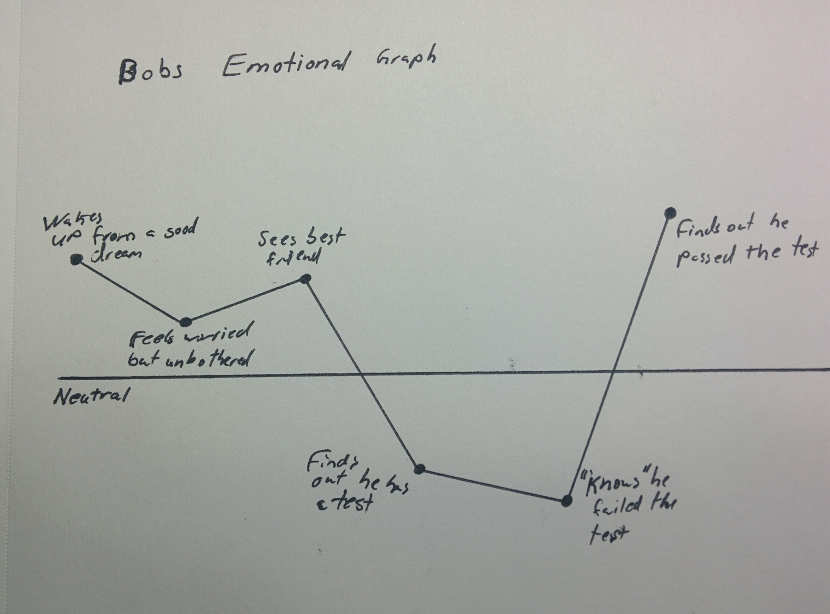Emotional Graph
Once again I attempt to commune to discuss yet another great tool for the production of one of our favorite visual storytelling mediums. Today I will explain the emotional graph and how it can help to organize the emotional flow of a story. As well as add emotional depth to all significant or disposable characters.
An emotional graph is something I came across in my research a while ago. There doesn’t seem to be much else I could find regarding this little treasure, but I am here to pass it on.
What’s An Emotional Graph

An emotional graph is a visual representation of a character or characters’ emotional flow throughout a story. It looks a bit like the picture you see above. (I apologize for my appalling handwriting)
This graph can help a writer see a character’s emotion and mood as they interact with a particular scene or character. They can see just how they will leave a confrontation with a particular stimulus, whether it be a pleasant or a distressing one. This can then help a writer better understand how their character would behave in their following interaction in the story.
How Do I Make One?
The first step, grab a piece of paper and pen or pencil. Draw a line through said paper, right down the middle. This line represents a neutral emotion.
To make the idea of graphing a character’s emotion or mood possible one must first consider a few things.
- What characters do I want my readers to focus on on an emotional level?
- A character’s character (I know I am such a literary wiz), what are the people you are writing about like?
- What is the scene that they are in like?
- What stressors surround them?
- What type of interactions are they taking part in?
- What is bothering them or occupying their mind?
- How would they feel about what is happening to them or those around them?
- What emotional progress do you want your characters to have?
- From which emotional state does your character begin?
- What outcome do you want from your character at the end of your story?
With this in mind consider the scenes or interactions that will have an emotional impact on your characters as they progress through the story. As well as just how many lines you will want this graph to have. Each line represents the character you want to focus on an emotional level.
Like the article so far? Support the production of more articles like this one!
Make Note Of
- The time that these events are happening to the character
- What scene the character is interacting with
- The outcome this scene has on both the character and plot.
- An explanation on how specific interaction will have an effect on both the character and plot
Helpful Note: Colour coding individual character emotional lines in your graph can help keep it neat. Remember, depending on how many characters you have, this graph may get a little crowded. Keep it simple and keep it clean.
Benefits
An emotional graph can be used not just for a single stand-alone graphic novel, comic book or manga. This scripting tool can be used to graph general emotional outcomes of entire arcs.
Other benefits of using an emotional graph are:
It’s A Visual Representation: It shows the emotional progression of the story to other interested parties, be it collaborating writers, artists, anyone closely interested in your work or yourself.
Helps With Scripting: Your characters are alive on the page. An emotional graph gives you an idea of your character’s mood. Let that drive the story forwards.
Good Editing Tool: Using an emotional graph can help a writer clear up any illogical interactions between characters or internal narrative. This keeps the story consistent with each sequential panel, page or book that your story progresses through.
I hope you found this particular scripting tool as insightful as I did. I believe that having used an emotional graph gave me a more in-depth understanding of my character’s character (see what I did there?)
It let me become much less of a creator, but more of a writer. I may have conceived my characters, but now they tell me how they will deal with the world I put them in. I may be able to sway them with interactions; but they are their own person now, their own ideal. They are beyond my conception. I could never make them do something that they wouldn’t do. Every character needs their purpose, their incentive, their reason for doing things. An emotional graph gives a writer this insight.
Sign Up For
The Unknown Times!
Content Updates
Website News
Recommended Reading
And More to Come!
*Once every two weeks!*
Liked the article? Become part of my Patreon Community!
About The Author

Phillip Allen
Writer, Editor, and Founder of Unknown Comics
Hello there! My name is Phillip Allen and I'm the writer, editor, and founder of Unknown Comics. I am an aspiring comic book creator. In an attempt to learn how to create my own comic I came to learn just how few reliable resources existed out there. From a few books and unhelpful websites I decided to focus my attention on researching and writing a resource for both myself and the rest of the comic creating industry. This website and and its content is the result of all of that hard work.

